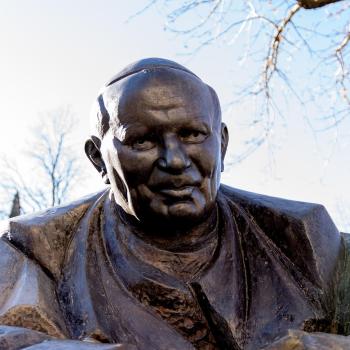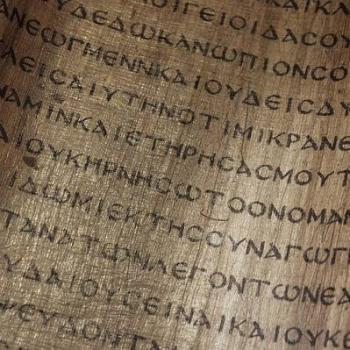RACHAEL ASKS:
A lot of people compare the differences between Sunni and Shiite Muslims with differences between Protestants and Catholics, but are these even in the same category?
THE GUY ANSWERS:
There’s some validity there, though religious comparisons are dicey. The obvious similarity is that both are divisions within great world religions. However, Islam is basically divided in two whreas Christianity has four segments, adding in Orthodox churches and indigenous churches in the developing world that are independent of western Protestantism.
The divisions’ chronologies are different. The Sunni-Shiite [or “Shia”] split occurred immediately after the founding Prophet Muhammad died in the year 632 C.E. without providing a clear-cut succession plan for leadership (see below). With Christianity, papal Catholicism dates from the early centuries — or in official Catholic teaching from Jesus’ appointment of St. Peter and the apostles he led, while Protestantism erupted far later, in the 16th century.
Both the Sunni-vs.-Shiite and Catholic-vs.-Protestant rivalries involve competing beliefs about religious authority. Catholicism gives the reigning pope and bishops who share “apostolic succession” with him the right to interpret and apply Scripture and sacred Tradition, with appointments of new bishops centralized at the Vatican. Protestants grant full authority to “Scripture alone,” though mediated by a group’s particular leaders and traditions, and they oppose Catholic church governance.
With Islam’s founding rivalry, what became the Sunni majority held that when Muhammad died his followers rightly agreed to give religious and political leadership to Abu Bakr, the Prophet’s close friend and one of his fathers-in-law, followed by subsequent choices as the caliph. The ancestors of Shiism contended that leadership should be restricted to the Prophet’s family or Ahlut Bayt (“People of the House”) and backed the Prophet’s cousin and son-in-law Alli, followed by a series of deeply revered imams in Ali’s line. (“Shiite” stems from “shiaat Ali,” meaning “partisans of Ali.”) Hostilities worsened when Sunni troops martyred Ali’s son, Imam Hussein. The two sides continued to share Islam’s core beliefs and practices, but developed religious differences too complex to delve into here.
The Shiite Website www.al-islam.org says the majority of Muhammad’s close “Companions” weren’t consulted when Abu Bakr gained control and some never recognized him as legitimate. Meanwhile the Sunni Website www.discoveringislam.org calls Shiite tenets “evil and blasphemous” and “a deviation from pure Islam” with no basis in the Quran or the Hadith (authoritative traditions of the Prophet’s words and deeds). An international Pew Research Center survey last year found that in much of the Mideast and North Africa “at least 40 percent of Sunnis do not accept Shias as fellow Muslims.”
The Shiite minority, at most 13 percent of the world’s Muslims, is highly localized. Two-thirds or more live in just four nations: Iran, where they dominate, along with Pakistan, India, and Iraq, with most of the rest in nearby Asian lands. By contrast, Christianity’s Protestant minority is widely dispersed across the planet.
Protestant-Catholic acrimony was at the heart of Europe’s disastrous Thirty Years War, which produced untold millions of deaths and great skepticism toward both faiths. Since then, with few exceptions (e.g. Northern Ireland) the Christian split has not fostered major bloodshed and is free of political or military aspects, whereas the Sunni-Shiite conflict has been evident in Mideast politics and warfare as well as in religion.
As is well-known, Iran’s revolution began an international upsurge in terrorism by factions claiming to act in the cause of Islam. In a horrid example September 22, a church suicide bombing in Pakistan murdered 81 worshippers and injured 120. It was the deadliest attack on Christians in the nation’s history.
But it’s important to realize the vast carnage that Muslim terrorists inflict on fellow Muslims. Consider the radicals in Afghanistan who target fellow Sunnis because they want to give girls basic schooling, or northern Nigeria’s vicious Boko Haram movement, which attacks not only Christians but fellow Sunnis who provide modern educations rather than schooling focused narrowly upon the Quran alone. Boko Haram is blamed for two recent attacks that murdered a total of 80 Muslim youths attending a high school and an agricultural college.
“The Economist” weekly provides thorough foreign affairs coverage and closely monitors the current intra-Muslim rivalry between the Sunni Gulf states over against a rising “Shia crescent” spanning Iran, major elements of the new Iraq, and Iranian-backed factions and troops in Syria and Lebanon. Though there have also been some Sunni-vs.-Shiite attacks, the most dangerous conflicts within Islam have more often not been along those lines.
The Guy’s patheos.com colleagues provide detail on Sunni and Shiite differences at:
www.patheos.com/Library/Shia-Islam.html
www.patheos.com/Library/Sunni-Islam.html
The Guy’s esteemed journalistic friend, the late Louis Cassels, wrote an interesting depiction of Catholic-Protestant differences that holds up rather well a half-century later:
www.religion-online.org/showchapter.asp?title=1623&C=1563












